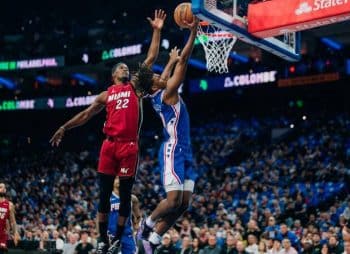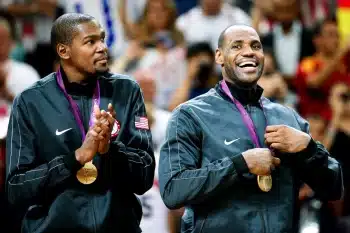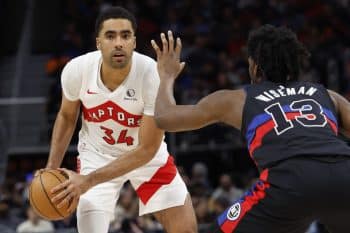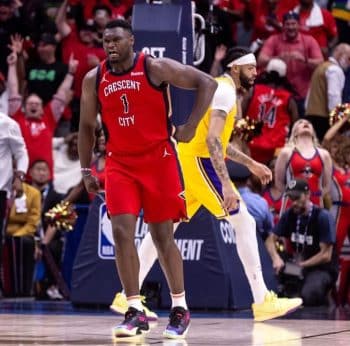NBA
NBA PM: Top Returning NCAA Draft Prospects

Top Returning NCAA Draft Prospects
Earlier this week, we took a look at the top five draft prospects for the 2015 NBA Draft, all of whom happened to be underclassmen who will be making their collegiate debuts at the start of the 2014-15 season. As much hype as the 2014 freshman class received, the 2015 freshman class could produce just as many first-round picks (nine). However, there’s going to be stiff competition as a few potential first round picks passed on the NBA for a year and the upperclassmen talent-level overall is quite intriguing despite the fact that youth is such a valuable commodity in the draft. Here’s a look at the top returners who you need to keep an eye on:
Willie Cauley-Stein – 7’0, 244 lbs. Jr., Center (Kentucky)
Had he declared for either one of the last two drafts, Cauley-Stein very likely would have been a lottery pick – a mid-first round selection at worst. However, he’s passed both times, with injuries playing a factor. Now, though, he’s returning to one of the most crowded frontcourts in the country with his perceived upside far less than it was after his freshman season.
Cauley-Stein’s production actually dropped off in his sophomore season, despite playing the same 23 minutes a game he did his first year. It’s hard to imagine him getting the same amount of run with all the talent that Kentucky has coming in and returning, so it’s really going to be important for him to make the most of the minutes he does get. Scouts know that Cauley-Stein is a quality finisher and shot blocker. Improvement in his low-post game and free throw shooting, which was sub 40 percent last year, will be key.
Because seven footers with his speed, length and his athleticism are always going to have a home in the NBA, Cauley-Stein’s floor is likely somewhere at the end of the first round this year, with the potential for him to still go in the same range he could have the last two years. But that’s only with marked improvements in areas we saw very little development from his freshman to sophomore years.
Sam Dekker – 6’9, 229 lbs. – Jr., Small Forward (Wisconsin)
A strong NCAA Tournament may have pushed Dekker onto the other side of the fence and into the 2014 NBA Draft. Dekker wasn’t at his best during the Badger’s run to the Final Four, though. In fact, it was arguably his least impressive stretch of the season, after looking every bit like a lottery pick early on in the year.
Dekker has a really nice all-around skill set and more than ideal size for a NBA small forward. He’s just consistently left scouts yearning for more throughout his first two years. As a junior he has to take the next step forward and be one of the best players on the floor like he’s capable of night in and night out, especially late in the year when it matters the most.
The Badgers are going in to the season as one of the favorites to get back to the Final Four, and if Dekker can help lead them there and produce at a higher rate, there’s no reason why he should be on the board past 20 come draft night.
Montrezl Harrell – 6’8, 230 lbs. – Jr., Power Forward (Louisville)
After exploding in place of the departed Gorgui Dieng as a sophomore, everyone thought that Harrell was as good as gone. Louisville was already set to lose a lot with Russ Smith and Luke Hancock to graduation, but Harrell shockingly decided to return for his junior season.
What makes scouts love Harrell is the fact that he doesn’t have an off switch. He plays with as much energy and aggression as any player in the country. At one point when they were in danger of getting upset by Manhattan in their opening round game of the NCAA Tournament, he seemed to be foaming at the mouth as he helped lead them to victory. That’s the kind of tenaciousness he plays with.
Although he lacks ideal size for his position, Harrell’s likely going to produce at a rate that cannot be ignored. In fact, given what the Cardinals have lost, there’s the potential for Harrell to actually improve his stock if he can excel as a featured option offensively. Had he entered this year’s draft he would have been looked at primarily as an energizer whose contributions would come on the glass and defensive end. If he consistently hits the mid-range jumper and gets good shots in the low post, look for him to shoot into the top 10.
Chris Walker – 6’9, 205 lbs. – So., Power Forward (Florida)
We only got to see glimpses of Walker last year as he had to deal with eligibility issues that cost him a good portion of his freshman campaign. Now, with the Gators losing a huge part of their core to graduation, the stage is set for Walker to showcase his entire arsenal and improve his stock significantly. As a bit of a mystery with plenty of potential he probably would have been a late first-round pick or early second-round pick at worst, but this upcoming season he could easily play his way into the top 10.
What made Walker a blue chip recruit out of high school was his elite-level athleticism and defensively versatility. He’s very raw, though, and somewhat positionless. Hopefully an offseason under Florida’s training program has helped him improve in those areas. He appears to be best suited for the power forward position. With a stronger frame, refined offensive skill set and a clear cut position, Walker could lock up a spot in the lottery of mock drafts in very short order.
Rondae Hollis-Jefferson – 6’6, 212 lbs. So., Small Forward (Arizona)
No one would have criticized Hollis-Jefferson if he decided to leave after his solid freshman season at Arizona. He probably would have went somewhere in the 20s, as scouts loved his defensive ability and athleticism. He has all the tools to be a high-level defender at the next level, but by coming back for his sophomore season he can change the way that he is looked at completely.
Rather than just being viewed a “3-and-D” guy, Hollis-Jefferson could work his way up the small forward rankings by displaying an improved offensive game – particularly with his ability to score out on the perimeter. He wasn’t much of a threat from beyond the arc last year; he doesn’t have to become Doug McDermott or anything like that as a shooter, but he simply has to prove that he’s capable of making more than two in 960 minutes like he did as a freshman.
Late in the season it seemed like things were really starting to click for Hollis-Jefferson, who did a good job of playing within himself and simply focusing on what he was asked. With Nick Johnson and Aaron Gordon gone, he’s going to have much more responsibility – so look for Hollis-Jefferson to potentially climb into the lottery with a big season.
Caris LeVert – 6’5, 170 lbs. – Jr., Michigan (Shooting Guard)
LeVert really shined in his expanded role as a sophomore, going from a seldom-used freshman to playing all but six minutes a game in year two. With the departure of Nik Stauskas, LeVert is poised to be the number one option for Michigan next season and if his next step forward is anything like his last, he could be one of the first swingmen taken on draft night 2015. He has NBA-caliber athleticism, height and length, but he needs to add a significant amount of strength. The added strength will not only help him in preparation for making the leap to the NBA, but make him a much tougher cover during what is likely his last season at Michigan. His goal should be to get to the free throw line at least six times a game in 2014-15.
Bobby Portis – 6’10, 235 lbs. So, Power Forward (Arkansas)
Nationally, Portis’ standout freshman season may have gone underappreciated, but he’s firmly on the NBA Draft radar going into his sophomore season. In fact, there was very little chance that he wouldn’t have been a first round pick had he decided to declare, but he didn’t give that option very much consideration at all.
Stretch fours have become almost more common than the traditional power forwards who prefer to play with their back to the basket than 15 feet away from it. Portis is comfortable no matter where he is on the floor and has good size and strength for the position. Expectations are going to be much higher for him, though, and he’s going to have to come close to putting up a double-double in order to improve his stock. Without top-tier athleticism, becoming more physical and welcoming of contact is going to be critical for the longevity of Portis’ NBA career.
Frank Kaminsky – 7’0, 234 lbs. Sr., Center (Wisconsin)
Beyond underwhelming his first two years at Wisconsin, “the tank” as he’s referred to really blew up at the end of his junior year. A 28-point outing against Michigan State in the Big 10 postseason tournament and a double-double of 28 points and 11 rebounds against Arizona in the Elite Eight pushed Kaminsky’s stock into the top eight. However, a disappointing outing against Kentucky’s younger, bigger and more athletic frontline showed that he wasn’t ready to take his game to the next level and he ultimately decided to return.
With his size and offensive versatility, which features a jump shot with deep range, Kaminsky has a long future of playing professional basketball in front of him. What’s going to determine whether that is in the NBA is how he handles the increased level of physicality that he’s going to see as a senior and his rebounding. NBA teams will look past the fact that he’s not a phenomenal athlete as long as he can find a way to utilize his high basketball IQ, improved strength and skill set to help negate that disadvantage.
Wayne Selden – 6’6, 223 lbs. So, Shooting Guard (Kansas)
Often overshadowed by his classmates Andrew Wiggins and Joel Embiid, Selden opted for a featured role as a sophomore over being a fringe first-round pick in the 2014 NBA Draft. With his size and strength, which are unique even at the NBA level for his position, he’s making a wise choice and has the potential to climb a great deal.
When Selden initially committed to Kansas there was some hope that he could develop into a point guard, where his physical advantages would be much greater than they are at the shooting guard spot. That may not ever happen, but he’ll undoubtedly have the ball in his hands more with Wiggins and Embiid’s departure. It’s going to be important for him to continue to focus on making the right basketball play as his light to score becomes greener. As a well-rounded shooting guard with improved consistency on his jump shot he could get into the top 15, which is right around where he would go if he looked capable of playing the point guard position at the next level anyway.
Aaron Harrison – 6’5, 210 lbs. So, Shooting Guard (Kentucky)
As the shooting guard version of the Harrison twins made clutch shot after clutch shot during the Wildcats’ run to the national championship game, there were very few who expected him to be back in Lexington for his sophomore season. Whereas his brother’s stock took a hit during the season, he maintained his status as a first-round pick and could have justified leaving.
Now, like his aforementioned teammate Cauley-Stein, he’s returning to a Wildcats backcourt that is much more crowded than it was last season. However, it’s hard to imagine Calipari having more confidence in anyone than Aaron late in ball games – so his minutes may not decrease like Cauley-Stein’s have the potential to.
Without great quickness or athleticism, Aaron is always going to rely on his IQ, strength and jump shot. By playing with more maturity and taking pride in his defense, two things he struggled with as a freshman, Harrison’s floor should remain late first round with the potential to climb into the 20s with a strong sophomore season.
Honorable Mentions: Andrew Harrison (Kentucky), Delon Wright (Utah) Dakari Johnson (Kentucky), Brice Johnson (North Carolina), Alex Poythress (Kentucky), Perry Ellis (Kansas), Shawn Long (Louisiana Lafayette), Ron Baker (Wichita State), Brandon Ashley (Arizona), Branden Dawson (Michigan State), A.J. Hammons (Purdue), Kaleb Tarczewski (Arizona), Jabari Bird (California), Jarell Martin (LSU) and Jordan Mickey (LSU).
Grizzlies Announce More Additions
The Memphis Grizzlies announced today that they have bolstered their coaching staff and player development team with several key additions to the organization.
Jeff Bzdelik (BIZ-del-ik), who has over 30 years of coaching experience, including 17 in the NBA, has joined Dave Joerger’s staff as an assistant coach. John Townsend, who previously served as shooting coach for the Toronto Raptors and Portland Trail Blazers, has joined the staff as director of player development. The Grizzlies also added Trevor Moawad, a recognized expert in the field of mental conditioning who has led mental endurance programs for the University of Alabama and Florida State football teams, as mental endurance coach.
“True to his word in a relatively short period of time, Robert Pera has meaningfully increased the resources available to our coaching staff and players,” Joerger said. “The addition of Jeff, who brings a wealth of knowledge to our sidelines and fits seamlessly within our culture, is just one of the many moves we made over the last few weeks to accomplish our singular goal of making the Grizzlies a world class organization. We are greatly appreciative of Robert’s efforts and I am confident that the addition of Jeff and others will benefit us in preparing for the upcoming season.”
Furthermore, Jason March, who previously served as advance scout, has been promoted to assistant coach/advance scout while Drew Graham, who previously was the head athletic trainer, has been promoted to head athletic trainer and vice president of player care. Additionally, the Grizzlies have also added several player development staff, strength and conditioning coaches and a physical therapist to the basketball operations staff.
Bzdelik, after six seasons as an assistant coach for the Washington Bullets (1988-94), worked seven seasons under Pat Riley, starting as a scout for the New York Knicks (1994-95) before becoming an assistant coach and advance scout for the Miami Heat (1995-2001). Hired by the Denver Nuggets in 2001, Bzdelik spent two-plus seasons as Denver’s head coach (2002-04) and in his second season guided Denver to a 26-win turnaround and a berth in the 2004 NBA Playoffs.
The Mount Prospect, Ill. native has coached on the collegiate level as an assistant with Davidson (1978-80) and Northwestern (1980-86) and served as head coach at the University of Maryland, Baltimore County (1986-88), Air Force (2005-07), Colorado (2007-10) and, most recently, Wake Forest (2010-14).
Townsend has been named director of player development after joining the Grizzlies last season as a shooting coach. Townsend also worked as a shooting coach for the Toronto Raptors (2011-14) and Portland Trail Blazers (2007-10) and the NBA Development League (2002-07) and served one season as a consultant for the Continental Basketball Association’s (CBA) Yakima Sun Kings (2002-03).
Moawad joins the Grizzlies organization to serve as mental endurance coach. Moawad has recently coached under Nick Saban at the University of Alabama and Jimbo Fisher at Florida State University, helping to guide and lead the development of the players off the field to ensure they are thinking at an elite level on the field. Through the integration of advanced mindset solutions, he has played a vital role in both schools winning NCAA Championships for their football programs in his tenure.
March will enter his eighth season in Memphis. March previously served the team as assistant video coordinator (2007-12), director of basketball information and technologies (2012-13) and advance scout (2013-14). Graham will begin his ninth season with the Grizzlies. Graham served the previous eight seasons as head athletic trainer in Memphis. He spent six seasons with the New Jersey Nets (2000-06) as assistant athletic trainer and strength and conditioning coach.











